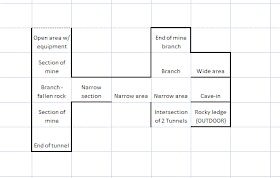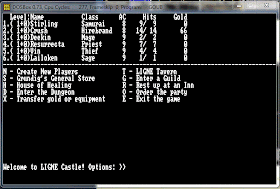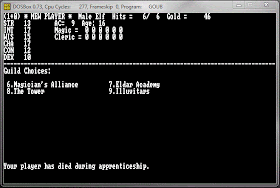In the case of Moebius, I refer specifically to the character icon that you have to stare at for most of the game: an enormous, cloaked head and top of a torso that stares creepily out at you. Your foes look the same. I almost can't bear the thought of looking at this for a couple dozen hours of gameplay. Didn't this bother anyone else during development?
This got me thinking about other games that have been ruined--or at least marred--by a particular element of the game. I'm not talking about substantive things, like Wizardry's permanent death or The Bard's Tale II's boring, interminable dungeons. I'm talking, rather, about peripheral or stylistic elements that should have been easy to change in the development stage. Obviously, a lot of them are going to come down to pet peeves, but this is the list I came up with:
- Baldur's Gate: "You must gather your party before venturing forth." Seriously, once should have been enough.
- Ultima II: Space travel, fine, I can deal with it. Being able to land and walk around on Jupiter, no.
- Ultima VII: I always choose the black character portrait because the one white guy looks like a baked out surfer. Seriously, like 90% of their players must be white males, and that was the best they could come up with?
- Baldur's Gate II: Throne of Bhaal. Cespenar. Yeah, he's cute at first, but having to cycle through all of his inane chattering every time I want him to examine my backpack makes me want to punch my cat.
- Neverwinter Nights: The Stone of Recall. It utterly breaks the game.
- Might & Magic VII: No respect from your own townspeople. You spend all this time upgrading your castle and building a peaceful Harmondale, and the guards still tell you to "move along."
- Oblivion: When the main quest is about stopping an invasion from hell, it seems irresponsible to do any of the side quests. Morrowind got around this by having Caius Cosades tell you to go out, explore, build up some experience, but there's no good role-playing reason to do that in Oblivion. Also, the character creation process allows you to choose from a detailed and nuanced selection of facial features, body styles, and hairstyles (including size, shape, and color for all of them)--except that there's no "bald" option. Which I happen to be.
I'm sure I'll run across many more. What are some astonishingly absurd or obnoxious gameplay elements that you've found?
Finally, here's one about the industry: why do game companies make it so hard to buy their older games? Instead of bitching about abandonware sites, why don't copyright holders offer their own versions of old games for download at a minimal cost? I'd gladly pay $5 for Ultima IV or The Bard's Tale or Pool of Radiance from a legitimate seller, but the owners offer no such recourse. I realize that many of these companies are out of business, but surely someone still owns the copyrights and can create a basic web site. I'm frankly worried about what's going to happen when I enter the "games that require a CD in the drive" era and find that there are no more copies of Baldur's Gate or Might & Magic VII to be had.













































